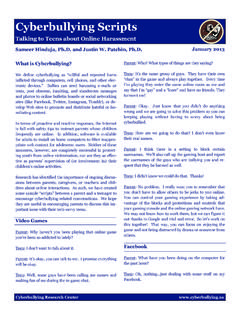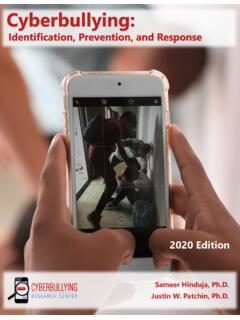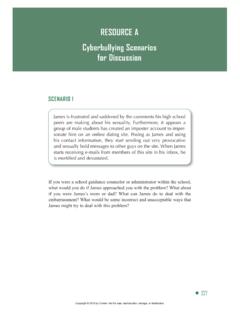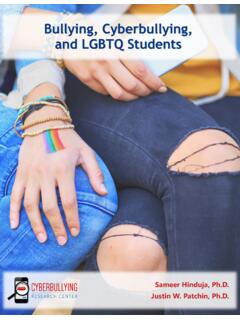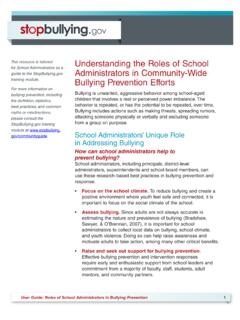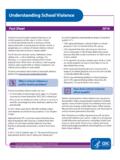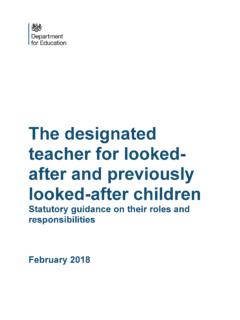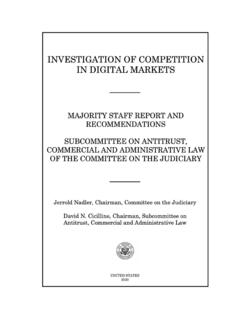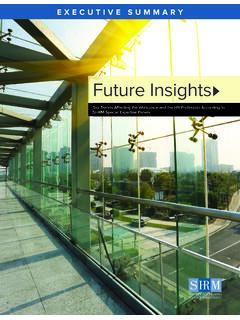Transcription of Cyberbullying Legislation and Case Law
1 Cyberbullying Legislation and Case Law Implications for School Policy and Practice Sameer Hinduja, and Justin W. Patchin, Updated: January 2015. Created: July 2008. Cyberbullying Research Center When we first started studying Cyberbullying over a dec- these laws are infrequently implicated. Also, most forms ade ago, very few states had comprehensive anti- bullying of Cyberbullying do not demand formal (legal) interven- Legislation and none of those included specific infor- tion ( , minor teasing). Like traditional bullying , cyber - mation about Cyberbullying . Now just about every state bullying behaviors vary significantly along a continuum has something on the books related to this issue. What is ranging from isolated, trivial, and innocuous incidents to more, federal law can be implicated in certain cyberbully- serious and enduring torment. The problem is that few ing incidents, especially when student speech is being can agree on the precise point at which a particular be- restricted or if one's civil rights are violated.
2 Because the havior crosses the threshold and becomes something that law is continuously evolving and little crystal-clear con- should be addressed in a courtroom. sensus has been reached regarding key constitutional and civil rights questions, schools struggle to appropriately address problematic online behaviors committed by stu- dents while simultaneously avoiding any civil liability. It is important to acknowledge before moving forward that we are not attorneys. Even those who are, and who specialize in harassment or student speech cases, struggle with the complexities involved in applying outdated legis- lation or conflicting case law new electronic communica- tions. With this in mind, this fact sheet will provide you with a summary of what is currently known, and you can apply this information to your unique situation (after careful consultation with appropriate legal counsel). Cyberbullying Legislation Most states have balked at passing new laws to further criminalize Cyberbullying and instead opted to direct As of January of 2015, forty-nine states (all but Montana) schools to deal with the problem.
3 When it comes to the have enacted bullying prevention laws (for a regularly authority and responsibility of schools to regulate student updated list of state Legislation , please see: speech, reference is usually made to one of the most influ- ). All of these require schools ential Supreme Court cases: Tinker v. Des Moines to have policies to deal with bullying , and almost all of Independent Community School District (1969). In Tink- them refer to electronic forms of harassment (or cyber - er, the Court ruled that the suspensions of three public bullying specifically), but there exists great variation school students for wearing black armbands to protest the across states regarding what exactly is mandated. Vietnam War violated the Free Speech clause of the First Amendment. A few states formally criminalize Cyberbullying ; that is, they specify criminal sanctions such as fines and even jail There are two key features of this case that warrant con- time for the conduct.
4 In addition, many Cyberbullying sideration. First, the behavior considered in Tinker oc- behaviors already fall under existing criminal ( , har- curred on campus. Second, the behavior was passive and assment, stalking, felonious assault, certain acts of hate or non-threatening. In short, the court ruled that: A prohi- bias) or civil ( , libel, defamation of character, inten- bition against expression of opinion, without any evi- tional infliction of emotional distress) Legislation , though dence that the rule is necessary to avoid substantial in- Cyberbullying Research Center 1. terference with school discipline or the rights of and other students.. others, is not permissible under the First and Fourteenth Amendments [emphasis added]. Thus, the Court clari- In Kowalski v. Berkeley County Schools (2011), a student fied that school personnel have the burden of demonstrat- created an online profile disparaging a peer which ing that the speech or behavior resulted in (or has a rea- seemingly precipitated another instance when a substan- sonable likelihood of resulting in) a substantial interfer- tial disruption took place.
5 Kara Kowalski was the high ence. This has become the default standard that schools school senior who created a MySpace group apply when evaluating their ability to discipline students page which she claimed was an acronym for Students for their misbehavior. And that is mostly true when it Against Sluts Herpes. However, other classmates later comes to off-campus behaviors as well. admitted that it was an acronym for Students Against Shay's Herpes, referring to another Berkeley County Schools' student, Shay N. (the main subject of discussion on the webpage). As a result, Kara was suspended for 10. days (which was later reduced to 5 days) for violating the school's harassment, bullying , and intimidation policy. Kara then sued the school for violating her free speech rights and due process. Upon deliberation, the lower court upheld the suspension and the case was appealed to the Fourth Circuit Court of Appeals which affirmed the lower court opinion, stating: Kowalski used the Internet to orchestrate a targeted attack on a classmate, and did so in a manner that was sufficiently connected to the school environment as to implicate the School District's recog- nized authority to discipline speech which materially and The School's Ability to Intervene in Off-Campus substantially interfere[es] with the requirements of appro- Cyberbullying priate discipline in the operation of the school and collid- [es] with the rights of others.
6 ' . One perennial area of contention among educators is when they can control or discipline the behavior or speech In short, courts have generally supported the reasonable of students that occurs away from campus. While this is discipline of students whose online behaviors away from still fairly murky legal water, some courts have upheld the school have substantially disrupted the learning environ- actions of school administrators in disciplining students ment at school. That said, there have also been a number for online behaviors that occurred off-campus. In v. of examples where schools overstepped their authority or Bethlehem Area School District (2000), the Common- applied unwarranted and unproductive discipline. wealth Court of Pennsylvania reviewed an incident where was expelled from school for creating a webpage that School Authority is Not Universal included threatening and derogatory comments about specific school staff. Just because schools can intervene in certain off-campus online incidents doesn't mean that they have universal In its ruling, the court made it clear that schools do have authority in all cases.
7 For example, in Emmett v. Kent the authority to discipline students when speech articulat- School District No. 415 (2000), the District Court for ed or behavior committed off-campus results in a clear the Western District of Washington reviewed a case where disruption of the school environment. Here, the school a student was initially expelled (the punishment was later district was able to strongly demonstrate disruption and a modified to a five day suspension) for creating a webpage negative impact on the target of the incident. The court entitled the Unofficial Kentlake High Home Page that concluded: Regrettably, in this day and age where school included mock obituaries of students and an online mech- violence is becoming more commonplace, school officials anism for visitors to vote on who should die next. The ma- are justified in taking very seriously threats against faculty jor issue in this case was that the school district failed to Cyberbullying Research Center 2.
8 Demonstrate that the website was intended to threaten ent in its response, which led to continued harassment. anyone, did actually threaten anyone, or manifested any What educators should take away from this ruling is that violent tendencies whatsoever. once they learn of such victimization taking place, they have a duty to do everything in their power to ensure that In v. Blue Mountain School District (2011), eighth- it stops. Simply disciplining the student who did the bully- grade honor roll student and her friend were suspend- ing is not enough; you must ensure that it actually stops ed for 10 days for creating a parody MySpace profile about and that the person targeted is safe. Responses to bullying their principal James McGonigle. The lower court that need to be targeted (focusing on the nature of the harass- reviewed the evidence supported the actions of the school, ment), comprehensive (long-term recurring programming ruling that students can be disciplined for lewd off- vs.)
9 A one-time brief presentation), and demonstrably ef- campus behavior, even if such behavior didn't necessarily fective (the bullying has to stop or at least be significantly cause a substantial disruption. On appeal, however, the reduced). Due diligence involves more than just applying Third Circuit Court of Appeals ultimately ruled that: an immediate response it demands that the response the school district violated 's First Amendment free move behaviors in the desired direction. speech rights when it suspended her for speech that caused no substantial disruption in school, and that could Implications for School Policy not reasonably have led school officials to forecast sub- stantial disruption in school. After carefully reviewing the language from many state laws and recent court cases, we advocate for six primary Overall, courts are oriented toward supporting First elements of what would constitute an effective school poli- Amendment rights of free expression of students.
10 Certain cy. They include the following: expressions, however, are not protected and allow inter- vention and discipline, including those that: 1. Specific definitions of harassment, intimidation, and bullying (including the electronic variants). substantially or materially disrupts learning; 2. Graduated consequences and remedial actions interfere with the educational process or school disci- 3. Procedures for reporting pline; 4. Procedures for investigating utilize school-owned technology to harass; or 5. Language specifying that if a student's off-campus threaten other students or infringe on their civil speech or behavior results in substantial disruption of rights. the learning environment, or infringes on the rights of other students, the student can be disciplined Cyberbullying Can't be Ignored 6. Procedures for preventing Cyberbullying Even though many school personnel are understandably These six areas, and the laws and cases behind them, are hesitant to get involved in cases of Cyberbullying that oc- explored in much more detail in our book: bullying Be- cur off-campus, they have a responsibility to stop any- yond the Schoolyard: Preventing, and Responding to thing that has the potential to deny a student a safe learn- Cyberbullying (2nd edition) which is available from Sage ing experience.



